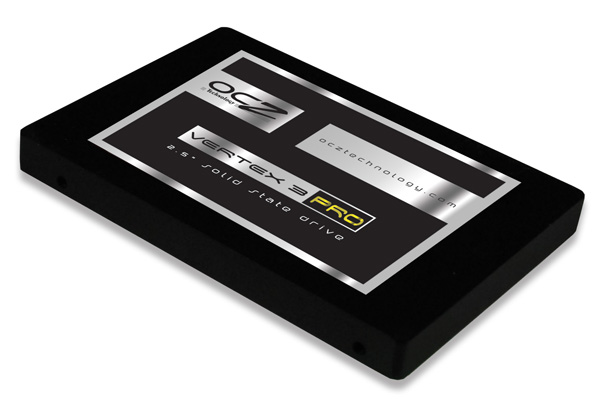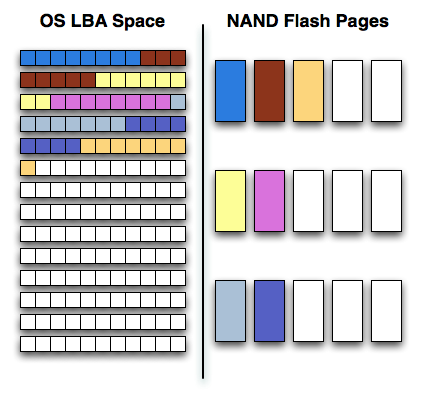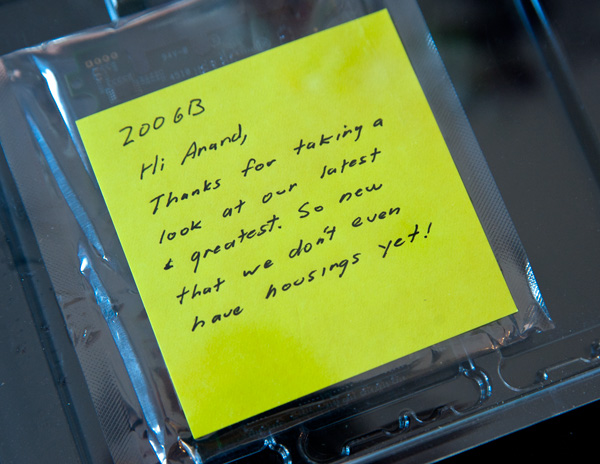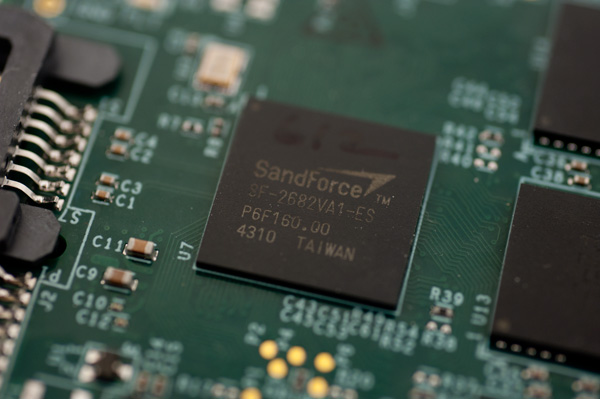OCZ Vertex 3 Pro Preview: The First SF-2500 SSD
by Anand Lal Shimpi on February 17, 2011 3:01 AM ESTFor the past six months I've been working on research and testing for the next major AnandTech SSD article. I figured I had enough time to line up its release with the first samples of the next-generation of high end SSDs. After all, it seems like everyone was taking longer than expected to bring out their next-generation controllers. I should've known better.
At CES this year we had functional next-generation SSDs based on Marvell and SandForce controllers. The latter was actually performing pretty close to expectations from final hardware. Although I was told that drives wouldn't be shipping until mid-Q2, it was clear that preview hardware was imminent. It was the timing that I couldn't predict.
A week ago, two days before I hopped on a flight to Barcelona for MWC, a package arrived at my door. OCZ had sent me a preproduction version of their first SF-2500 based SSD: the Vertex 3 Pro. The sample was so early that it didn't even have a housing, all I got was a PCB and a note:
Two days isn't a lot of time to test an SSD. It's enough to get a good idea of overall performance, but not enough to find bugs and truly investigate behavior. Thankfully the final release of the drive is still at least 1 - 2 months away, so this article can serve as a preview.

The Architecture
I've covered how NAND Flash works numerous times in the past, but I'll boil it all down to a few essentials.
NAND Flash is non-volatile memory, you can write to it and it'll store a charge even if you remove power from the device. Erase the NAND too many times and it will stop being able to hold a charge. There are two types of NAND that we deal with: single-level cell (SLC) and multi-level cell (MLC). Both are physically the same, you just store more data in the latter which drives costs, performance and reliability down. Two-bit MLC is what's currently used in consumer SSDs, the 3-bit stuff you've seen announced is only suitable for USB sticks, SD cards and other similar media.

Writes to NAND happen at the page level (4KB or 8KB depending on the type of NAND), however you can't erase a single page. You can only erase groups of pages at a time in a structure called a block (usually 128 or 256 pages). Each cell in NAND can only be erased a finite number of times so you want to avoid erasing as much as possible. The way you get around this is by keeping data in NAND as long as possible until you absolutely have to erase it to make room for new data. SSD controllers have to balance the need to optimize performance with the need to write evenly to all NAND pages. Conventional controllers do this by keeping very large tables that track all data being written to the drive and optimizes writes for performance and reliability. The controller will group small random writes together and attempt to turn them into large sequential writes that are easier to burst across all of the NAND devices. Smart controllers will even attempt to reorganize data while writing in order to keep performance high for future writes. All of this requires the controller to keep track of lots of data, which in turn requires the use of large caches and DRAMs to make accessing that data quick. All of this work is done to ensure that the controller only writes data it absolutely needs to write.

SandForce's approach has the same end goal, but takes a very different path to get there. Rather than trying to figure out what to do with the influx of data, SandForce's approach simply writes less data to the NAND. Using realtime compression and data deduplication techniques, SandForce's controllers attempt to reduce the size of what the host is writing to the drive. The host still thinks all of its data is being written to the drive, but once the writes hit the controller, the controller attempts to reduce the data as much as possible.

The compression/deduplication is done in realtime and what results is potentially awesome performance. Writing less data is certainly faster than writing everything. Similar technologies are employed by enterprise SAN solutions, but SandForce's algorithms are easily applicable to the consumer world. With the exception of large, highly compressed multimedia files (think videos, MP3s) most of what you write to your HDD/SSD is pretty easily compressible.
You don't get any extra space with SandForce's approach, the drive still has to accommodate the same number of LBAs as it advertises to the OS. After all, you could write purely random data to the drive, in which case it'd behave like a normal SSD without any of its superpowers.
Since the drive isn't storing your data bit for bit but rather storing hashes, it's easier for SandForce to do things like encrypt all of the writes to the NAND (which it does by default). By writing less, SandForce also avoids having to use a large external DRAM - its designs don't have any DRAM cache. SandForce also claims to be able to use its write-less approach in order to use less reliable NAND, in order to ensure reliability the controller actually writes some amount of redundant data. Data is written across multiple NAND die in parallel along with additional parity data. The parity data occupies the space of a single NAND die. As a result, SandForce drives set aside more spare area than conventional controllers.
What's New
Everything I've described up to this point applies to both the previous generation (SF-1200/1500) and the new generation (SF-2200/2500) of SandForce controllers. Now let's go over what's new:
1) Toggle Mode & ONFI 2 NAND support. Higher bandwidth NAND interfaces mean we should see much better performance without any architectural changes.
2) To accommodate the higher bandwidth NAND SandForce increased the size of on-chip memories and buffers as well as doubled the number of NAND die that can be active at one time. Finally there's native 6Gbps support to remove any interface bottlenecks. Both 1 & 2 will manifest as much higher read/write speed.
3) Better encryption. This is more of an enterprise feature but the SF-2000 controllers support AES-256 encryption across the drive (and double encryption to support different encryption keys for separate address ranges on the drive).
4) Better ECC. NAND densities and defect rates are going up, program/erase cycles are going down. The SF-2000 as a result has an improved ECC engine.

All of the other features that were present in the SF-1200/1500 are present in the SF-2000 series.












144 Comments
View All Comments
Slimline - Thursday, February 17, 2011 - link
This sounds interestingTrefugl - Thursday, February 17, 2011 - link
Indeed. I'm particularly liking the conclusion:'We're still a couple months away from knowing exactly what to buy, but if you've been putting off that move to an SSD - 2011 may be the year to finally pull the trigger"
That pretty much describes me perfectly. I do have an SSD in my work's workstation, but for home, but I've been holding out for 2011 (IMFT 25nm NAND) and I'm thinking I might not be disappointed by the wait.
Drag0nFire - Friday, February 18, 2011 - link
Indeed. I'm particularly excited to see what will happen when Intel shows up to the fight.MeanBruce - Friday, February 18, 2011 - link
Intel announced their 510 SSD G3 series today, it will come in 120Gb and 250Gb capacities, SATA3 6Gb/s, read/writes of 470Mb/s and 315Mb/s respect, and will be priced at $280 and $580! It's not using an Intel controller word is Intel doesn't have an in house controller with any real speed! SandForce is really shakin' things up! ;)MrBrownSound - Friday, February 18, 2011 - link
woah, no kidding. I'm looking forward to any reviews of it.MeanBruce - Saturday, February 19, 2011 - link
I knew when Intel pulled their G3 SSD lineup by rescheduling the release it had nothing to do with time constraints and everything to do with the numbers released shortly after by OCZ about their new SandForce controllers, 500/500 read/writes had Intel drawing up an entirely new gameplan for the new G3 lineup! But honestly I thought they would just let a little more magic out of the bag, I had no idea their bag was empty! Now I found out the new 510 series that becomes available March 1st is just going to use a Marvell controller just like the new Crucial and Corsair drives. I still love my X-25M but it's sad when a company with that many resources kicks back on their laurels. Oh well the good news is SandForce is here and with their new client Seagate we will have lots of choices and overall it's just great for the industry at large! Just sucks to watch the one time leader down so low!Out of Box Experience - Saturday, February 19, 2011 - link
Over 50% of the boxes on the Planet still run XPSo, the big question is...
Which one is XP compatible Out of the Box?
I'd love to buy a Sata 3 SSD that can saturate my XP Sata 2 ports but should we stick with Older/Slower Intel Sata 2 SSD's for compatibility??????
Any comment on this issue?
anactoraaron - Monday, February 21, 2011 - link
I know everyone has their own reason for keeping XP... but if you want to buy a $200+ SSD how can you not pony up the 100 for windows 7?Besides, 2 more years until XP is officially obsolete...
Out of Box Experience - Monday, February 21, 2011 - link
Bla bla blaHaving Windows 7 does not mean we all need to throw out our XP Licences and all our software that does not run on 7
Why can't somebody just answer my question instead of changing the subject
We get it! You love all the spyware and DRM built into Windows 7 but others don't
So lets just stick to the question I asked shall we?
Which Sata 3 SSDs will be Alignment agnostic at the very least so they can be used on ANY O.S. besides Spyware 7?
bennyg - Monday, February 21, 2011 - link
Bla bla bla spyware bla drm bla blaYou forgot to mention how locking DX10 to Vista/7 was a deliberate ploy to force gameplayers to upgrade.
And how Win7 is just Vista done right.
Far out some people hold grudges. I was ambivalent about Win7 when it was forced upon me - but for multicore + SSDs you just can't consider an old OS that wasn't designed when they were on the radar.